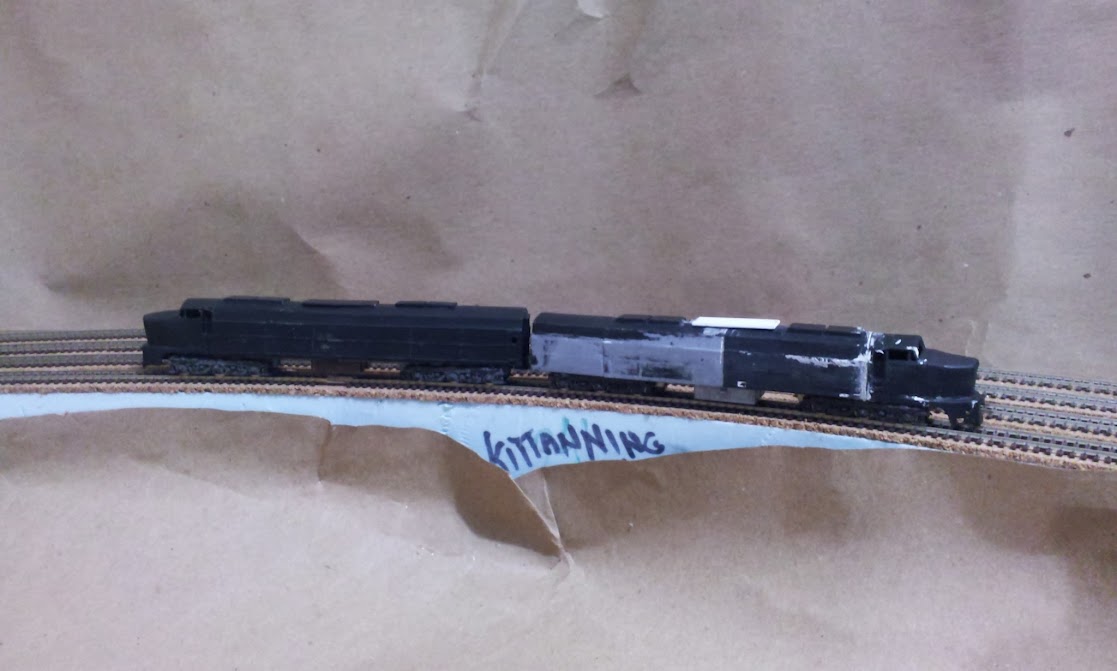The Allegheny Eastern now has a fair amount of steam power. I'm hoping to obtain at least two of the more numerous steam classes. It's not that I'm trying to collect the most locomotive models, it's that I'm trying to give some inkling of what the words "Pennsylvania Railroad" really meant.
The same goal has been set for diesel power. The roster of the Allegheny Eastern will be a sampler of American internal combustion locomotives. While some roads might order specifically from Alco or EMD, PRR purchased the products of every major manufacturer. Units from Fairbanks-Morse, Electro-Motive, Baldwin, Alco, General Electric, and Lima-Hamilton all worked together.
Having spent over a hundred years dealing with steam power, it took a while for the management of the Pennsy (and other roads) to get used to internal combustion. While they understood the low maintenance and availability of the new technology it appears they hadn't realized that diesels also provide flexibility. The idea of multiple units had a different application. It seems that switchers may have been run as individual units. I've found no mention of anything but classification by manufacturer, function and horsepower. An SW-1 seems to have always been a ES6, not an ES1. All the images I have of switchers from the era show single units. If more horsepower was required than a bigger diesel was purchased. Rather than lash four or five SW1's together the PRR bought monster switchers like the 2500 horsepower centercabs from Lima-Hamilton. These beasts were used to transfer long strings of cars from one yard to another...
| PRR Class LS25, Lima-Hamilton 2500HP Switcher |
Unlike the switchers, road engines were multiple units, but they were matched sets. A lot of roads ran their cab units this way, much as GM ran the original FT demonstrator. In fact, EMD sold the early units this way. If you ordered more horsepower you got more units. Some of the first "diesel houses" were built rather long so they could service these "sets" all at the same time. The set could be connected with drawbars rather than couplers, as in the BP2 / BP60 centpede. The mix and match lash-ups of the 1950's and later were not common yet.
As far as application, the PRR management put their heads together and decided that a train required a 6000 horsepower locomotive. This appears to have been applied to steam and diesel. All the steamers built in the late 1930's and early 1940's, the S, J, T, and Q classes, developed the equivalent of 6000 HP or better. The internal combustion units were operated as 6000 horsepower sets. Passenger units, which all developed 2000 horsepower, ran in sets of three's. Freight units, typically 1500 horsepower each, ran in gangs of four.
Whether or not this is all historically accurate I cannot vouch for but my personal research seems to indicate that this was the case. As far as the Allegheny Eastern is concerned, however, this is standard operating procedure. All diesels are run as 6000 horsepower sets, whether passenger or freight. I've also used the diesel classification system that was adapted by the PRR for a short time in the post war era. Over the past months I was able to gather up the remaining units to make the sets...
 |
| PRR Class AP3: 6000HP Alco PA A-B-A Set |
 |
| PRR Class BF4: 6000HP Baldwin DR-4-4-1500 A-B-B-A Set (see below) |
 |
| PRR Class EF4a: 6000HP EMD F-7 A-B-B-A Set (see below) |
 |
| PRR Class FP3 / FF3: 6000HP Fairbanks-Morse Eriebuilt A-B-A Set |
 |
| PRR Class EP3: 6000HP EMD E7 A-B-A Set |
 |
| PRR Class BP3 Baldwin DR-6-4-20 A-B-A Set (see below) |
While some of the sets are complete, some are stand-ins or incomplete. The BF4, for instance are actually ER models of the Baldwin RF-16. Since the major difference between the two Baldwin freight sharks is horsepower, only minor changes are required to represent DR-4-4-15 units. The EF4 could consist of Electro-Motive F3 models. Since F3's and F7's had the same horsepower I'm guessing the Pennsy may have classified the F3 as EF4 and the F-7 as EF4a. The BP3 still requires a B unit to be complete. The one missing class is the BP2, the two unit set of Baldwin DR-12-8-30 centipedes are presently just Bachmann DD40 parts in a box. I've made two attempts to create a shell and disliked both of them.
I believe that the introduction of higher horsepower diesels like RF16's and E-8's put an end to the unusual diesel class system. I'm not sure exactly when this took place but I think the PRR adopted the single unit classification in the early 1950's. Only the Baldwin centipedes were still classed as a set. The BP2 became the BP60, a six thousand horsepower beast that was unmatched until the Union Pacific added the big General Electric turbines to it's roster.
I hoping that I can recreate some of the drama of the struggle up the East Slope. Once again these extinct species will round Horseshoe Curve on their way to Gallitzin...
 |
| Mountains Tower Over A Set of Passenger Sharks |
Regards,
Frank Musick
Building a dream layout on a nightmare budget,


No comments:
Post a Comment